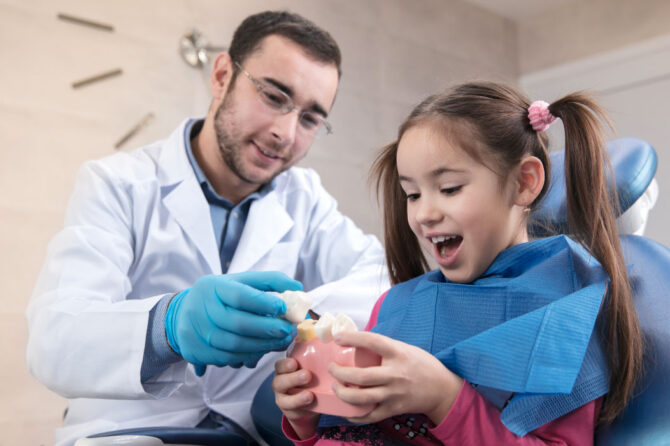
How is pediatric dentistry different from adult dentistry?
What is tooth development and why is it important for pediatric dentistry?
The two things, tooth development is dependent on are genetics and environmental factors. These environmental factors include nutrition, trauma, infection, etc. There are different stages through which odontogenesis (tooth development) go through which dictate the overall shape of the teeth. The stages include initiation period, bud stage, cap stage, bell stage representing histodifferentiation and morpho differentiation, apposition and lastly maturation. It is important for a good pediatric dentist to know the intricacies of these stages as pediatric dentistry not only involve dealing with adult permanent teeth but only the primary milk teeth.
Why do children have to see their dentists more than an adult?
As we can deduce from the above section, the developmental stages of teeth result in the emergence of primary teeth first. As primary teeth are very delicate and prone to disorders, it is important for them to be regularly checked. A pediatric dentist is the doctor who is responsible for the dental care of your children from the day they are born through their adulthood. It is important for this doctor to be well skilled as there are more development disorders of teeth than the disorders caused by environmental situations. It is recommended to children to see their dentist at least two times a year for the betterment of their delicate set of milk teeth
What are primary teeth and how are they different from permanent teeth?
It is very necessary to include primary teeth when we are talking about the subject of pediatric dentistry. The structural difference between primary and permanent teeth is that the former has thinner enamel than the latter. Also, the enamel is more uniform in depth around the tooth. The dentin layer is thinner in primary teeth as well. Through this information we can easily say that if the enamel and dentin are thinner, the pulp is naturally going to be larger. Because of the thinner protective layers, there is always risks of caries, tooth wear and pulp exposure. This is the reason pediatric pulp therapy is one of the common pediatric dental treatments seen in dentistry.
What are some important developmental disturbances seen in pediatric dentistry?
Different categories of developmental teeth problems are:
Anomalies of number in teeth
This type of problem occurs during the initiation stage of teeth development. In this category, you get either extra or missing teeth respectively known as supernumerary teeth or congenitally missing teeth.
Anomalies of size in teeth
Paediatric doctors explain this type of teeth developmental problems by its main disorders, which are as follows:
- Microdontia
- Macrodontia
- Fusion
- Germination
Shape anomalies of teeth
Dens evaginates, dens invaginates, taurodontism and dilacerations are the most commonly seen problems in the shape of teeth. In these conditions, the patient can suffer from following situation
- Extra cusp in teeth
- Tooth within a tooth
- Vertically elongated pulp chamber
- Abnormally bent tooth
Problem in the structure of teeth
Treatment of this category is one of the most common things in the paediatric dental treatments. When it comes to the structure of teeth, one can develop following problems:
- Underdeveloped enamel
- Abnormal mineralization resulting in white spots
- Internal alteration of enamel due to genetic factors
- Internal alteration of dentin
- Ghost teeth disorder
- Union of two adjacent teeth
What are some routine procedures done in pediatric dentistry?
Fillings
As already explain that children are prone to developing dental problems such as caries and tooth wear, they remain at high risk of getting cavities. It is important for them to get their teeth filled because the cavity in primary teeth can reach to the pulp very rapidly. Usually environmental causes such as exposing your teeth to sour or acidic beverages can lead to the problem of eroding enamel. This condition cannot be treated to recover the lost enamel but can be prevented to cause further harm by tooth filing. With performing a filing, the pediatric dentist may also advice your children to bring some healthy changes in their diet and routine.
Inserting Stainless Steel Crowns
In order to prevent any harm to the underdeveloped or rotted molar teeth of your child, the doctor may insert a teeth crown made up of stainless steel on those teeth. This is a very common and effective procedure to ensure the prevention of developing disorders in these teeth.
Tooth Extractions & Space Maintainers
Space maintainers are dental appliances that are put in the place of the prematurely released teeth so as to act as a fill in between the remaining teeth. This is done to safeguard these vacant positions and to make sure that the permanent teeth are aligned properly.
Conclusion
Pediatric dentistry is a multidiscipline practice in which the pediatric dentist is aware and skilled in wide range of dentistry specializations. Pediatric dental treatments certainly vary from treatment in adult dentistry as primary teeth present some unique challenges. The most significant challenge in this practice is the inclusion of treatments developmental disorders in teeth. It is essential for you to seek a skillful and experienced pediatric dentist for your children. If you are in search for a dental advices and efficient dental procedure for your child, Visit Dr. Kisha Mehta and Dr. Umangi Lekhadia at Kids Dental Studio in Ahmedabad.
Leave a reply